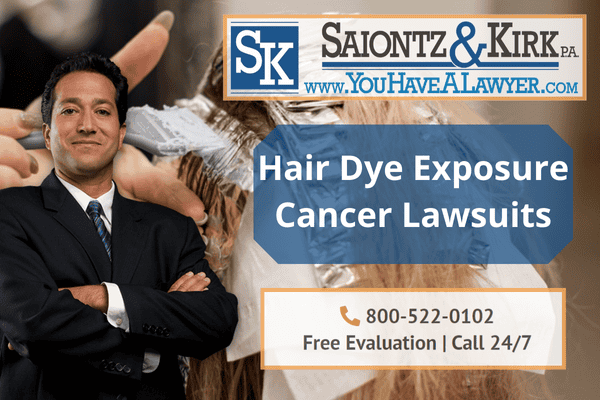Hair Color Lawsuits Over Bladder Cancer
Hairdressers and salon workers throughout the United States are pursuing hair dye lawsuits against product manufacturers, for failing to warn that routine exposure to toxic chemicals in hair dye products may cause them to develop bladder cancer.
Research by the National Institute of Environmental Health Sciences (NIEHS) and findings published in other prominent medical journals have established a link between the routine handling of hair dye products by salon workers and a risk of developing bladder cancer.
Hair dye products contain a range of well-documented carcinogenic and endocrine-disrupting chemicals, such as aromatic amines (like p-Phenylenediamine) and formaldehyde. However, it doesn’t appear that manufacturers adequately disclosed the serious risks that salon workers may face, even if all recommended safety precautions were followed.
Licensed salon workers and hair stylists are now pursuing hair dye bladder cancer lawsuits against product manufacturers for their failure to adequately warn about the potential health risks associated with these hazardous substances.
Medical research has also linked the exposure to chemicals in hair relaxers to certain cancers. Our lawyers are filing hair relaxer cancer lawsuits for women who have received multiple hair relaxer treatments and developed uterine cancer, ovarian cancer, or other types of reproductive cancers.
Who Can File a Hair Dye Cancer Lawsuit?
The hair dye lawyers at Saiontz & Kirk, P.A. are reviewing bladder cancer lawsuits for individuals who were routinely exposed to chemicals in permanent hair dye while working in a hair salon, including:
- Hairdressers
- Cosmetologists
- Hair stylists
- Hair colorists
- Hair technicians
- Other salon workers
To help determine the hair dye lawsuit settlement amount that you or a loved one may be eligible to receive, request a no-obligation case evaluation today.

Permanent Hair Dye Chemicals Increase Cancer Risks
The use of permanent hair dyes in women has been a common practice at professional hair salons for decades. While many cosmetologists and hair stylists have been led to believe these products are safe, manufacturers often fail to disclose a series of endocrine-disrupting and cancer-causing chemicals that may pose serious health risks with repeated exposure.
Permanent (oxidative) dyes chemically alter the hair shaft, making the color long-lasting until replaced by new growth. These dyes, sometimes called coal-tar dyes, contain colorless substances like aromatic amines and phenols, which react with hydrogen peroxide to form pigments. Darker dyes require higher concentrations of these chemicals.
Research has raised concerns about semi-permanent and permanent hair dyes, particularly darker shades, due to their higher levels of potentially carcinogenic compounds.
Cancerous Hair Dye Chemicals
Permanent hair dyes contain several hazardous chemicals that have been linked to cancer. Notable toxic substances include:
- P-Phenylenediamine (PPD): A common ingredient in permanent hair dyes, PPD has been associated with an increased risk of bladder cancer.
- Aromatic Amines: Compounds such as o-phenylenediamine and 4-chloro-o-phenylenediamine have demonstrated carcinogenicity in animal studies.
- Formaldehyde: Some hair dye products can release formaldehyde, a known carcinogen, during application.
- Resorcinol: Used as a coloring agent, resorcinol is linked to endocrine disruption and potential carcinogenic effects.
- Ammonia: Commonly used to open the hair cuticle, ammonia exposure can lead to respiratory issues and has been linked to cancer risks.
Manufacturers Failed to Provide Warnings to Hairdressers
While some hair dye products include basic cautionary statements about skin irritation or patch testing, most fail to provide explicit warnings about long-term health risks and do not instruct cosmetologists to wear protective gloves, masks, or have ventilation systems when handling hair dyes to minimize exposure.
This lack of warnings has left salon professionals who routinely handle permanent hair dyes unknowingly exposed to toxic chemicals due to the absence of clear and adequate safety guidelines from manufacturers.
How Could Manufacturers Better Protect Salon Professionals?
While the FDA, OSHA and other health and safety organizations emphasize the importance of protective measures when handling hair dyes, manufacturers have failed to provide clear, standardized guidelines for professionals working with these products daily.
Hair dye brands could significantly reduce exposure risks by:
- Clearly stating cancer risks on packaging and product inserts, particularly for stylists with long-term exposure.
- Providing specific instructions on wearing nitrile or non-latex gloves to prevent skin absorption of chemicals.
- Advising the use of masks or respirators to minimize inhalation of fumes from volatile organic compounds (VOCs) and formaldehyde.
- Recommending proper ventilation systems in salon settings to reduce airborne chemical exposure.
- Educating professionals on how to safely store, mix, and dispose of chemical hair dyes to prevent prolonged exposure.
How Does Hair Dye Cause Cancer?
Hair dye can cause cancer through repeated or prolonged exposure to toxic chemicals like formaldehyde, PPD, and aromatic amines, which salon professionals frequently absorb through the skin, inhale as fumes, and accumulate in the body, increasing the risk of developing bladder cancer.
Absorption Through Skin
Salon professionals are exposed to formaldehyde, PPD, and aromatic amines when applying permanent hair dyes directly to clients’ hair. Even when gloves are used, these chemicals can come into direct contact with the skin, allowing carcinogens to be absorbed into the bloodstream.
Once absorbed, formaldehyde and aromatic amines have been linked to both bladder and breast cancer. These chemicals can accumulate in the body over time, leading to chronic exposure that increases the likelihood of DNA mutations and abnormal cell growth.
Inhalation of Fumes
During hair dye application and processing, salon workers inhale fumes containing formaldehyde and VOCs. Poor ventilation in salons increases respiratory exposure, especially for stylists who apply multiple dye treatments per day. Over time, repeated inhalation of these toxic chemicals can lead to systemic absorption and long-term health risks.
Exposure to airborne formaldehyde and aromatic amines has been linked to bladder cancer. These chemicals can disrupt hormone function, trigger inflammation, and damage DNA, leading to uncontrolled cell growth and tumor formation in the bladder.
Accumulation of DNA Damage
Hair dye chemicals like PPD and formaldehyde can interact with DNA in exposed cells, leading to genetic mutations. Salon professionals who frequently handle these dyes are at risk of long-term cellular damage, increasing the chances of developing cancerous growths.
DNA mutations caused by chronic exposure to hair dye chemicals have been strongly associated with both bladder and breast cancer. When DNA damage occurs in bladder cells, it can lead to abnormal tissue growth and tumors, while hormonal disruption from endocrine-disrupting chemicals can increase the risk of hormone-related breast cancer.
Salon Worker Hair Dye Bladder Cancer Risk
In a study published in the International Journal of Epidemiology , researchers found that hairdressers have a 30% higher risk (RR 1.30) of developing bladder cancer compared to the general population.

The study systematically reviewed 247 research papers and identified chronic exposure to toxic chemicals in hair dyes, including aromatic amines and other potential carcinogens, as a significant contributing factor to elevated bladder cancer risks among salon professionals.
“These professionals are chronically exposed to a large number of chemicals present in their work environment, including potential carcinogens contained in hair dyes.“
The researchers further highlighted the importance of improved safety measures, reinforcing concerns that insufficient manufacturer warnings and a lack of protective guidelines may have contributed to the long-term health risks faced by cosmetologists and hairdressers.
“Improvement of the ventilation system in the hairdresser salons and implementation of hygiene measures aimed at mitigating exposure to potential carcinogens at work may reduce the risk.”
Permanent Hair Dye Breast Cancer Risk
While our law firm is not actively investigating hair dye breast cancer cases at present, several medical studies have indicated a potential link between hair salon workers’ exposure to chemicals in hair color products and an elevated risk of breast cancer.
According to the National Cancer Institute, professional hairdressers and others who frequently handle hair dyes as part of their job are likely exposed to higher levels of potentially harmful chemicals compared to individuals who only have their hair dyed in a salon or at home.
Research has shown a link between frequent exposure to chemicals in permanent hair dyes and an increased risk of breast cancer, particularly with darker hair dyes that contain higher concentrations of carcinogenic compounds.
Hair Dye Exposure Increased Breast Cancer Risk
While many studies focus on individuals who personally use hair dyes, the same exposure risks apply to hairdressers and cosmetologists, who routinely handle and inhale these chemicals throughout their careers.
Repeated skin contact and airborne exposure to the toxic ingredients in permanent hair dyes put salon professionals at an even greater risk than individual consumers.
A study published in Carcinogenesis found that:
- Black women who frequently used dark hair dyes had a 51% increased risk of breast cancer.
- White women who used both hair dyes and hair straightening products had 2.4x increased risk of developing breast cancer.
- White women who used dark hair dyes had an increased risk of Estrogen Receptor-Positive Breast Cancer.
Given that salon professionals are exposed to these products daily, their cumulative exposure is likely even higher than individual users, reinforcing concerns that hairdressers and cosmetologists face an elevated occupational risk of developing breast cancer.

Permanent Hair Dye Breast Cancer Study
In the Sister Study, performed by the National Institute of Health, researchers analyzed data from 46,709 women to evaluate the link between hair dye use and breast cancer risk. Researchers found that women who regularly used permanent hair dyes had a higher likelihood of developing breast cancer compared to those who did not. The study found:
- Women who used permanent hair dye in the year before enrolling had a 9% increased risk of developing breast cancer.
- Women who used permanent dyes every 5 to 8 weeks or more had a 60% increased risk of breast cancer.
Allegations Raised In Hair Dye Bladder Cancer Lawsuits
Similar to allegations raised in many hair relaxer lawsuits being pursued over the cancer risks from chemical hair straighteners, manufacturers of permanent hair dyes have failed to provide adequate warnings about the dangers of prolonged exposure to toxic chemicals like formaldehyde, PPD, and aromatic amines.
Despite the well-documented risks, numerous salon workers, hairdressers, and cosmetologists who have developed bladder cancer after years of mixing, applying, and washing off hair dye are now seeking compensation from manufacturers for:
- Failing to disclose the full extent of the health risks associated with prolonged exposure.
- Failing to warn salon professionals about protective measures such as gloves, masks, and improved ventilation.
- Failing to reformulate hair products to reduce carcinogenic exposure despite growing evidence of health risks.
By not properly informing professionals, manufacturers have increased the likelihood of salon workers developing serious, life-threatening illnesses due to chronic exposure to these toxic chemicals.
Are there any costs to hire a lawyer for my hair dye lawsuit case?
There are absolutely no out-of-pocket costs to receive a free hair dye cancer claim evaluation, or hire our attorneys. Potential claims are evaluated for individuals throughout the United States, and all cases are handled on a contingency fee basis.
Through the use of contingency attorney fees, individuals have access to the experience and resources of our national law firm for their hair dye lawsuit settlement — regardless of their individual financial resources.
You pay nothing up front to hire our lawyers, and we only receive an attorney fee or expenses out of the money that is obtained from the manufacturers. Our law firm receives nothing unless we win your case!
What are the steps in a hair dye exposure case evaluation?
Complete Our Case Evaluation Request Form. Providing contact information and some information about your hair dye case.
Get Contacted by Saiontz & Kirk, P.A. You will be contacted by our law firm to help determine if financial compensation may be available for you and your family.
You Decide If You Want to Move Forward. If our lawyers determine that we can help with your case then you decide whether to move forward and hire us to pursue compensation.

